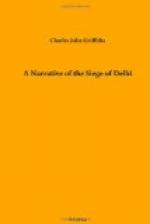This church in which we were now quartered had been sadly desecrated by the rebels and fanatics of the city. They had, in their religious zeal, torn down the pulpit and reading-desk, defaced emblems, broken up the pews and the benches, and shattered all the panes of glass, while here and there inside the building were remains of their cooking-places, with broken fragments of utensils. The walls, too, had suffered much from the effects of our bombardment from September 11 to 14, the church being in the line of fire directed on the bastions. Many, no doubt, would consider it a sacrilege to quarter English troops in this sacred edifice, but the exigencies of war required its use for this purpose, and of all the buildings occupied by us during our stay in Delhi, the church was found to be cleanest and best ventilated, free from the noisome smells and close atmosphere of the native houses.
The close of the 18th saw our outposts extended hard by the Chandni Chauk—the main street of the city—the bank, Major Abbott’s and Khan Mohammed’s houses having first been seized by our men, who suffered severely from the field-guns and musketry of the rebels. There was also another unsuccessful attack made on the Burn bastion and Lahore Gate by the right column, in which the 75th lost one officer and many men killed. The arrangements for attack seemed to have been bad and ill-advised; the soldiers felt the want of the guiding genius of Nicholson, and, during an advance through a narrow lane were literally mown down by grape from the enemy’s field-guns.
The weather, which since the 14th had been fine, broke up on the night of the 18th, and was succeeded by a terrific storm of rain, which fell in torrents like a deluge. That night it was reported that the rebels in great numbers were evacuating the city by the south side, the Bareilly and Neemuch brigades making off in the direction of Gwalior. Certain it is that from this period signs of waning strength appeared among the enemy, and fewer attempts at assault were made on our outposts, those on the left near the Palace, which were well protected by breastworks, being only exposed to a very desultory fire of musketry.
During the forenoon of the 18th there was, I think, a partial eclipse of the sun, which lasted three hours. The unusual darkness which prevailed astonished us beyond measure (our minds being taken up with events more startling than astronomical phenomena) till reference to an almanac explained the mystery. The eclipse had, we were told, an alarming effect on the mutineers, who attributed the phenomenon to some supernatural agency. The darkness no doubt worked on their superstitious fears, and hastened their flight from the city on which the wrath of the Almighty had descended.
September 19.—On the 19th operations in front of the Palace Gate were continued, a heavy fire being kept up against that place, while the 60th Rifles and others, perched on the tops of houses, took unerring aim at the rebels clustered in the open space. The same evening, also, the exertions of the right column were rewarded by the capture of the Burn bastion, with little loss on our side.




